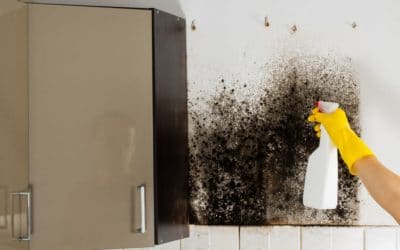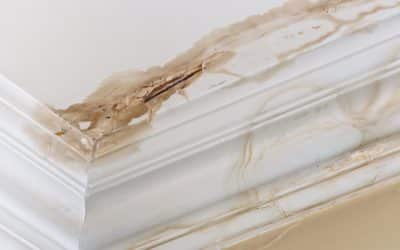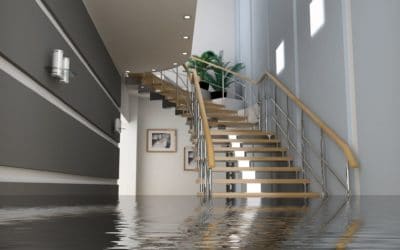What is Water Damage Restoration?
Water damage restoration can return your home to the way it was before the damage occurred. Water restoration is a specialized service that removes water from your home and restores it to a livable, pre-damaged condition.
While it’s understandable to feel panicked when your home has flood damage or another water intrusion, it’s also important to realize you need to act as quickly as you can. The longer you wait, the more extensive the damage will get–and the longer the water cleanup will take.
Water can cause more than structural damage to your home. It can also present a serious health hazard. It doesn’t take long for standing water to breed mold and bacteria, pathogens that can cause severe respiratory illnesses, and other problems.
Water Damage Removal & Water Cleanup
Removing this water can be extremely challenging and this job should be left to a professional. Water damage repair is much more than just vacuuming up the water you can see. You have a lot of porous materials throughout your home and they can quickly absorb excess moisture.
Water can quickly get deep into drywall and other materials. If it absorbs too deeply, that could threaten the structural integrity of your home. That’s why fast action is so critical. It could mean the difference between being able to keep insulation, drywall, insulation, and carpeting, or these components becoming damaged beyond repair.
Restoring a home after emergency water damage must happen quickly. Standing water and moisture create a perfect environment for bacteria and mold growth. Exposure to a water-damaged environment can result in allergic reactions, illness, and other adverse health effects.
Water cleanup can be a challenging task. The level of restoration required depends on the class and category of water destruction that occurred and can range from simple vacuuming and drying to complete reconstruction projects.
Water Restoration vs Water Mitigation
Restoration and mitigation refer to two separate services provided after a water incident occurs. While water mitigation focuses on prevention, water restoration deals with damage.
Water mitigation services are used to prevent further damage from occurring in the first place. A water mitigation company will focus on removing your belongings from the water source and preventing future damage.
Water damage restoration is performed after the damage has already occurred and is usually an emergency service. During the restoration, specialists repair or replace materials that were destroyed, and return the home to its former state.
When to Call a Professional for Water Damage Repair
You’ll know pretty quickly whether your water damage cleanup is a job you can tackle on your own or if you’ll need a professional. If you have any doubt whatsoever, or you have any reason to feel that trying to do this kind of job yourself will be dangerous, contact an expert immediately.
Calling a professional for water damage repair can help put your mind at ease because you’ll know the job will be done right. As a result, you’ll be able to get back to normal much faster.
But choosing the right professional will take a little research. Your best bet will be to find a water damage cleanup professional certified by the Institute of Inspection, Cleaning and Restoration Certification (IICRC). This is a regulatory organization that establishes standards for water damage restoration.
IICRC-certified experts will be able to provide services that are thorough and effective. They follow the best industry practices and keep up to date on the latest technology and techniques. Whether you’re dealing with water damage due to a sewage backup, flood, mold accumulation, storm, or fire, an IICRC-certified expert will be your best choice.
Once you find a water damage restoration company you’re comfortable with, you’ll want to ask a few questions before they get to work. Here are just a few examples:
- What is your process of water damage restoration?
- How long will it take you to start work?
- Can I stay at home while you’re working, or will I need to relocate?
- Will you work with my insurance company, or do I need to handle the claim on my own?
What to Expect During the Water Damage Repair Process
After a water damage event such as a burst pipe, leaking water heater, or flood damage, it is critical to respond quickly and start the restoration as soon as possible.
Water damage restoration is a five-step process that starts with an inspection and ends with restoring your home to its previous state. Every step of the process serves an important purpose, ensuring that all water and contaminants are properly identified and removed.
Whatever the cause of the damage, fixing it typically entails a five-step process: inspection and assessment, water removal, drying and dehumidification, cleaning and sanitizing, and finally, restoration and water damage repair.
Water Damage Restoration Process in Detail
Step 1: Inspection and Assessment
Water damage restoration professionals will come to your home to make a detailed assessment. They’ll use advanced equipment, such as hygrometers and moisture detectors, to get an idea of how much water damage repair work will need to be done. These experts will pinpoint the location of the damage and then classify it.
There are four levels of water damage, ranging from Class 1 to Class 4. Class 1 damage is relatively minor, while Class 4 damage is extensive. Class 4 damage is referred to as “bound water.” This means that water has absorbed so deeply into materials such as sheetrock and flooring that it can only be removed by using advanced techniques and equipment.
Restoration companies perform a thorough damage assessment of the damage location. During this inspection, a water restoration specialist will make assessments to categorize and classify the damage that has occurred.
Water restoration experts will check the porousness of the materials in the impacted area to determine how much water absorption has occurred. Moisture detectors, including hygrometers and moisture scourers, will measure the level of damage and estimate the amount of work required. Based on the findings, they will rate the damage from Class 1 to 4.
After an inspection has occurred, the water restoration company will tell you the approximate time and costs required to restore your home, as well as payment options.
Water damage inspectors will also identify the water source to ensure the water has stopped and to determine the contamination level of the water. The inspector will also check to see that the water intrusion has stopped, and will check to see how badly the water in your home has been contaminated.
There are three categories of water contamination: Categories 1, 2, and 3.
- Category 1 – Clean water is coming from a sanitary source and does not pose a significant health risk.
- Category 2 – Gray water poses a substantial risk for sickness if consumed or even touched because it is significantly contaminated. This often includes toilet bowl overflows, dishwasher discharge, water from washing machines, and more.
- Category 3 – Black water is a grossly contaminated type of water containing many types of dangerous pathogens and biohazards. Seawater intrusion, toilet backflows, and water from rivers and streams are a few examples. Black water can lead to severe illness and infection.
While most homes require water mitigation, removal, and restoration services, that’s not always the case. For example, a small, temporary water leak that is mitigated within 24-48 hours may not require complete water restoration services, as mold isn’t likely to grow within that timeframe.
Step 2: Water Removal
The next step in the restoration process is to remove standing water via water extraction.
Standing water can continue to damage your home, causing further deterioration, so all it must be removed as quickly as possible. During Step 2, water is removed from the home and belongings. Water removal and extraction often occur between or alongside mitigation and restoration services.
Water restoration companies use extractors to remove water during the extraction process. These high-powered pumps and vacuums are designed to absorb all standing and surface water from your home quickly.
Several different types of extractors may be used to remove water, including:
- Submersible pumps
- Truck-mounted vacuums
- Portable wet/dry vacuums
After the standing water is extracted, additional inspections may occur to determine the remaining moisture levels and identify whether the carpeting or hardwood floors need to be removed.
Step 3: Drying and Dehumidifying
After the water is physically extracted from the home, restoration companies begin the dehumidification and drying process. Industrial-quality air movers and dehumidifiers are used to dry out any materials that still contain water or were too challenging to access during extraction.
At this stage, your home may look dry, but some materials can be wet to the touch. If left alone, these materials may suffer further damage such as warping, breaking, or growing mold. Water restoration contractors prevent this by completely drying and dehumidifying the impacted area.
Throughout this stage, water remediation specialists monitor moisture levels in the walls and floors of the affected areas to determine when your home is dry so that professional cleaning can begin.
Step 4: Cleaning and Sanitizing
Thorough, professional cleaning is a required step in all home restoration projects. At the same time, restoration companies work to preserve as much of your personal property as possible.
Cleaning should always be performed by experts trained in the safety and sanitization requirements of water-damaged homes.
Cleaning may take many forms, including:
- Spray and wipe cleaning
- Dry cleaning
- Wet cleaning
Restoration professionals may also use foam, abrasive, or immersion cleaning techniques to ensure every item is cleaned as thoroughly as possible. This step may also involve mold remediation as necessary.
Experts have specialized personal protective equipment (PPE) for cleaning potentially hazardous materials, including N-96 respirators, protective gloves, and waterproof clothing.
At this stage, restoration specialists also dispose of any damaged materials that were removed during the cleaning phase.
Step 5: Complete Restoration
The final step of the water damage restoration process is the actual restoration. During the restoration, specialists return your home to the state it was in before the damage occurred. Any materials that were permanently damaged or removed will now be fixed or replaced. Restoration projects may be simple or extensive, depending on the amount of permanent damage that occurred.
In some cases, restoration can require relatively simple repairs, such as drywall repair or carpet cleaning. In others, restoration work is extensive and will require complete reconstruction on parts of your home.
If you are experiencing water damage and need water damage restoration in Brevard County, contact Affordable Water and Mold Removal. We are available 24/7.




